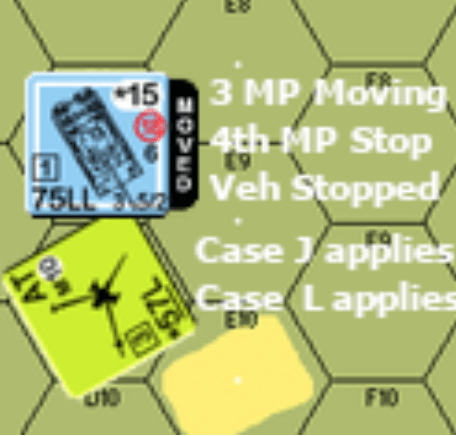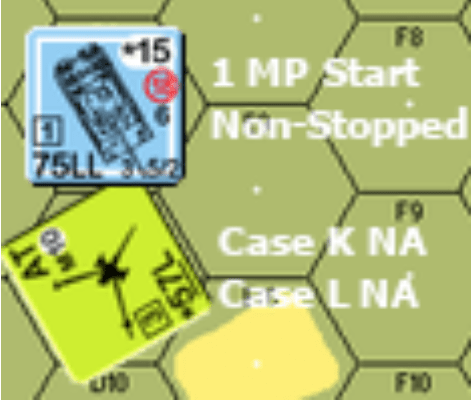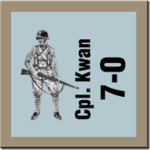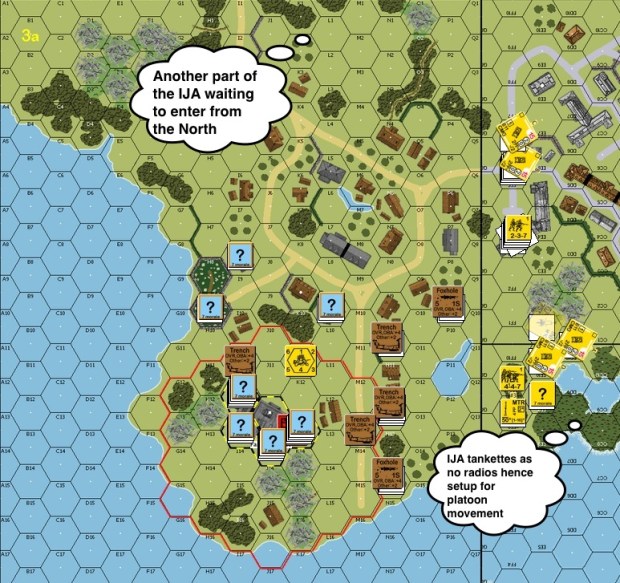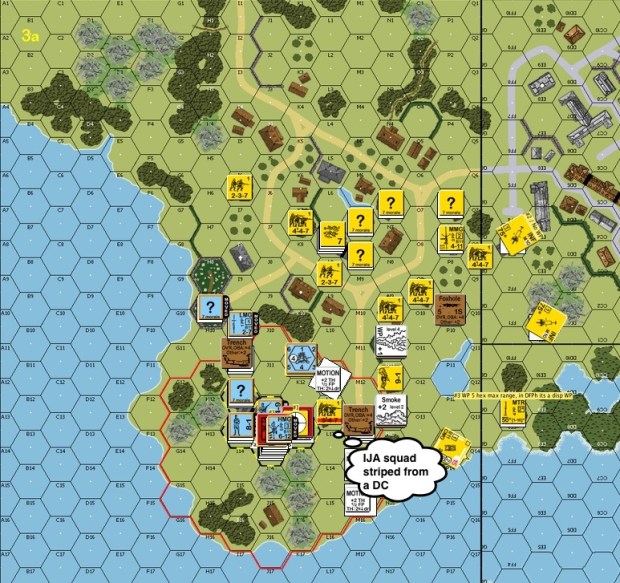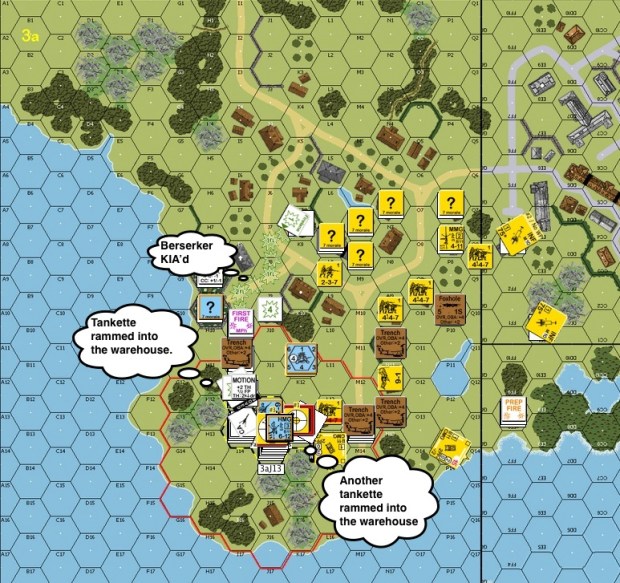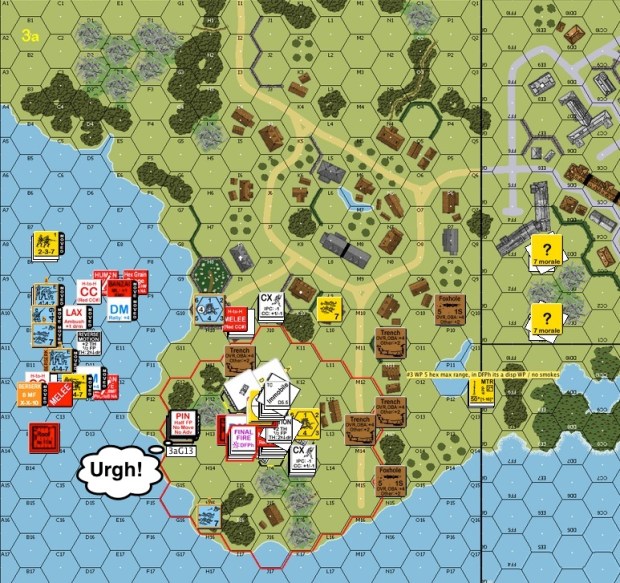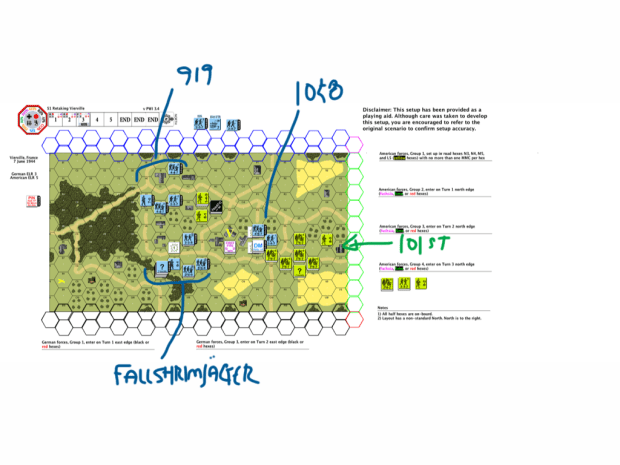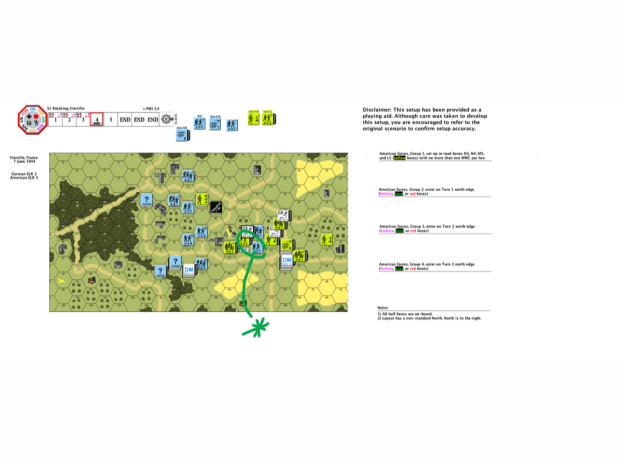(Author: Jim Bishop)
In August 2021 I attended the ASL Scandinavian Open tournament in Copenhagen. The French have OBA in WO33 “One-Eyed Jacques.. Walking around the room twice I observed players incorrectly convert a Spotting Round to a Fire For Effect (FFE). The scenario is an ideal case study for this all-too common error.
For this article I have excerpted a section of the OBA flowchart I will be referring to throughout the article. Understanding this section of the flowchart is key to placing and converting a SR effectively. Conversely, knowing the nuances of this section will help you frustrate your opponent’s attempts to attack with OBA. To make our
discussion clearer I have labeled two of the bubbles, one called A and one called B. Also recall the errata posted in Journal 11 changing AR to SR in bubble B.
For our purposes, we will assume you have successfully navigated the flowchart to the point where you maintained Radio Contact, announced your intention to convert, rolled for accuracy, and corrected the SR if needed. You are now ready to convert it to a FFE.
It is not enough to simply announce your intention to convert a SR as some players presume. There are a couple of crucial conditions which must be met before a SR can be successfully converted to a FFE.
We will first consider bubble A. There are two possible conditions tested in this bubble to determine how we proceed:
- The Observer has an LOS to the Base Level of the SR hex. Normal LOS rules apply (Blind hexes, LOS Obstacles, LOS Hindrances, etc).
- The Observer has an LOS to the Blast Height of the SR (C1.32) AND a Known Enemy Unit in or adjacent to the SR’s hex. Because the blast of an SR is visible two levels above the Base Level of a hex, it is possible for an Observer to see a SR in an otherwise Blind Hex. If there are no KEU’s in or adjacent to the SR’s hex the SR remains in place unconverted (the “No” path from bubble A).
- Per footnote d, Concealed Units in non-Concealment Terrain are considered known to the Observer for purposes of conducting OBA actions.
Next, let’s look at converting the SR to an FFE covered in bubble B. To convert we need two things: a LOS to at least the Blast Height of the SR and an enemy unit. There is a case where an enemy unit is not required and we will examine that shortly.
Observer only has LOS to the Blast Height: When an Observer cannot see the Base Level we already know what happens if there are no KEU in or adjacent to the Blast Height; the SR remains unconverted and we never make it to this bubble. Since there must be one or more KEU and at least one of them must be known to get to bubble B, the SR is converted to a FFE and resolved (the “No” path from bubble B).
Observer has LOS to the Base Level: It gets more interesting when an Observer has LOS to the Base Level of the SR’s hex. Here we will be following the paths from bubble B. Again, we have to ask if there are enemy units in or adjacent to the SR hex. If the answer is no, the SR is converted and resolved using the “No” path. If the answer is yes, we must ask a second question: are all of them Unknown to the Observer. Note footnote “d” telling us Concealed Units in non-Concealment terrain are considered KEU for the purposes of conducting OBA actions. If the answer is no (i.e. at least one of the units is known to the observer) then the SR converts to a FFE using the “No” path. If the answer is yes (i.e. all enemy units in or adjacent to the SR hex are unknown to the Observer) then an extra chit draw must be made from the existing OBA pile. This is the “Yes” path. If the xdraw is black, the card is shuffled back into the draw pile and we follow the “Black” path converting the SR into a FFE. If the draw is instead Red, the card is again shuffled back into the deck and follow the “Red” path resulting in Access Lost and removal of the SR.
Keep in mind the special case of Harassing Fire. While all of the rules about enemy units in or adjacent to the SR remain in play, any units located in the “outer ring” of a Harassing Fire FFE mission do not force extra chit draws. If an Observer has an LOS to the base-level and there are no unknown enemy units in or adjacent to the SR’s hex, the SR will convert to an FFE regardless of how many unknown units there are in the “outer ring” of the affected blast area.
From this brief note, there are some lessons to be learned here:
As the Defender:
- Concealed Units are your friend. They make conversion more difficult.
- Carefully watch placement of AR/SR and see if you can sort out where his Observer is. If
you can stay out of his LOS, conversion is more difficult. - If you can force an extra chit draw it is possible you can negate the mission and make
him start over again with a new card draw. - Knowing the flowchart is essential to effectively defending against OBA
As the Attacker:
- Be careful where you place your SR. If it drifts to a hex where you have LOS to the Base
Level of the SR’s hex and there are only unknown enemy units in or adjacent to the SR’s
hex you could be forcing an extra chit draw. - An enemy skulking in a woods line can be mauled pretty badly with Harassing Fire even
when out of LOS. - Knowing the flowchart is essential to effectively attacking with OBA.
Examples: For this section please refer to the illustration. The Observer is in 13aI5 on level 2. Three SRs are on the labeled SR — A, SR — B, and SR — C. We will discuss each of these in turn.
SR — A: The Observer has LOS to the Base Level of the SR. As such, we flow from bubble A to bubble B. There are enemy units in or adjacent to the SR’s hex. The unit is un-Concealed and in the LOS of the Observer. As such, it is a KEU meaning we flow from bubble B via the “No” path and convert the SR to an FFE and resolve it.
Were the 4-6-7 Concealed the situation would be entirely different. In that case, there are units in or adjacent to the SR’s hex and they are unknown to the Observer. We would flow from bubble B via the “Yes” path and make an extra chit draw. If the draw is a black chit we follow the “Black” path and convert the SR to an FFE and resolve the attack. If instead a red chit is drawn we would follow the “Red” path, Lose Access, and remove the SR.
SR — B: The Observer does not have LOS to the Base Level of the SR’s hex but he does have LOS to the Blast Height. Looking in bubble A, when the Observer has LOS to the Blast Height, we need to determine if the Observer has LOS to KEUs in or adjacent to the SR’s hex. In this case, there are two units Adjacent to the SR, but both are out of LOS of the Observer and do not meet the requirements of bubble A to leave via the “Yes” path. As such, we leave bubble A via the “No” path and the SR remains in place unconverted.
SR — C: For this one, the Observer is trying to convert the SR to an FFE Harassing Fire. In this case the Observer has LOS to the Base Level of the SR. We leave bubble A via the “Yes” path. In bubble B, we ask if there are enemy units in or adjacent to the SR. There are none so we exit bubble B via the “No” path and convert the SR to an FFE Harassing Fire. Even though the two 4-4-7s will be attacked by the FFE AND they are out of LOS of the Observer, the SR will still be converted. These units are not in or adjacent to the SR’s hex so they do not affect the conversion to FFE process.
Clearly, there is more to attacking with, and defending against, OBA than offered in this brief note. If you would like to see more about this or some other topic let me know what interests you and I may take that on. I hope this brief article is useful and if you find any errors please let me know and I will correct them. — jim
(Carried with Jim Bishop’s permission)
Original posted here : https://jekl.com/2021/09/10/converting-a-spotting-round-to-fire-for-effect/






